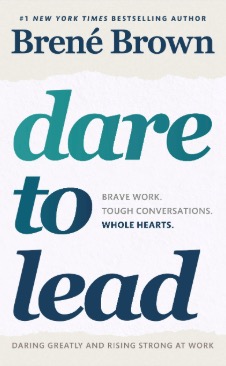Brené Brown’s latest is not for managers, bosses or people who want to get a promotion. It’s actually for you and me
Here’s why you should totally read this book.
1. It’s a life guide
Even if you’re not in a leadership position at work, there is so much learn from this book. Becoming a leader of one’s own self is a necessary part of living up to one’s fullest potential.
Brown, a research professor in the Graduate College of Social Work at the University of Houston, defines a leader as “anyone who takes responsibility for recognizing the potential in people and ideas, and has the courage to develop their potential.” She became known for her 2010 TED
In her 2018 book, Brown tells personal stories about her life at work and at home. The result is a compelling story that reveals how our values enact themselves—or fail to enact themselves—at home and at work. In short: self-awareness improves everything.
If we’re living in our values, our lives will feel better, and therefore we’ll have more energy and impact on the people we spend time with and the communities we live in.
So instead of doing shallow work—leadership as a set of behaviours—we can start to do deeper work on values—leadership as a mindset—to see lasting, meaningful change in our lives.
2. It will help you bring your humanity to work
This book a practical guide to putting values into practice. And Brown gives permission to take on such a lofty goal with a sense of compassion for self. In fact, many of the stories she uses from her own life show how vulnerable and fallible she is.
She’s constantly pointing out her flaws. At one point, she describes how her team–the group of people who help her lead leadership events, publish books and courses, and perform academic research about how humans work–confronted her with the fact that she tends to dramatically underestimate the amount of time projects will take.
As a result of her failure to see the time that goes into the work she assigns them, she often places unreasonable deadlines on her employees, and they feel a sense of failure when they fail to reach them–even though they were unreasonable.
She talks through her defensive, denying response, and then also how she came to see that they were right, and that their feedback could be extremely helpful—if she could listen and adjust.
Brown offers the wisdom that you don’t always have to know what you’re doing. But as a leader (of yourself), you should def be able to give and receive feedback skillfully.
Feedback is a skill that is constantly overlooked in the workplace, but Brown’s book promises to fix that by putting skilled feedback at the heart of organizational culture.
This is a practical skill that can be learned in a relatively short amount of time. It’s also a transformative nugget of action that people can use to make life better for everyone, no matter their place on the hierachy.
This book has inspired me to want to create a feedback culture everywhere I go. Is it the missing piece?
3. It includes practical writing prompts
Throughout her book, Brown offers simple exercises and writing prompts that can help this book come to life.
For example, in Part Two, Living Into Our Values, she asks readers to choose two core values from a list of values she uses in her work as a leadership coach, or to write their own.
After narrowing down a list of 80 possible values to only two core values, readers are asked to visualize how those core values would look as behaviours in their own lives.
For each of those two values, Brown asks: “What are three behaviours that support your value?” And: “What are three slippery behaviours that are outside your value?” And: “What’s an example of a time when you were fully living into this value?”
After I identified “excellence” and “connection” as my core values, I have been doing Brown’s writing prompts frequently. Each time I do them, the details are different, and that gives me practical wisdom for the small challenges I expect to meet in my day.
This one exercise, done repeatedly, is an incredibly efficient and affordable way to glean personal value from Brown’s book.
Doing this work solo is also a way to cultivate a sense of inner leadership and authority. Can you show up to noticing your own behaviours? Can you take a moment to self-reflect before you speak? Can you coach yourself up, rather than put yourself down?
Practicing prompts from Dare To Lead and also participating in Brown’s online community are ways to immerse yourself. You don’t need a coach. You need to coach yourself.
Do you want meaningful accomplishment?
Do you want to lead yourself toward a goal?
Do you want to be an amazing parent?
If so, you should read this book.
Like this review?
For more reading inspiration and recos, subscribe to my newsletter.

Published by